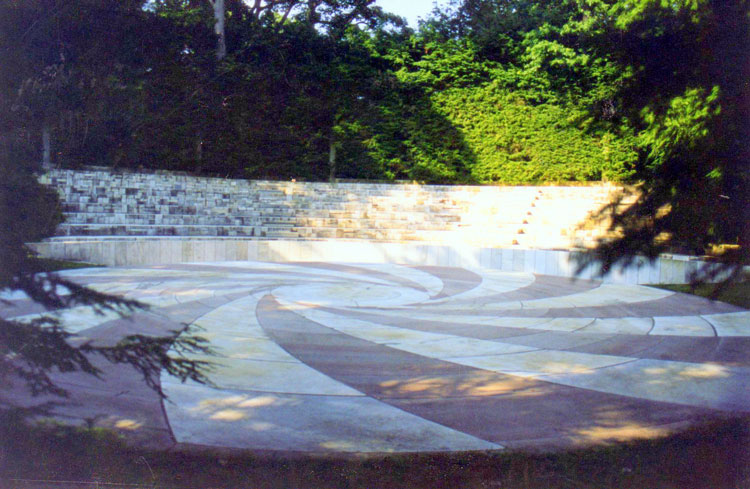

By Anne W. Semmes
Sentinel Columnist
On a recent warm summer night, I weathered a steamy Shakespeare performance of “Troilus and Cressida” with Greenwich friends in the outdoor Delacorte Theater in Central Park. It was a challenging play about egos and war between the Greeks and the Trojans. On the way home, the O’Neil Greek amphitheater in Cos Cob suddenly came to mind. I would have preferred seeing that play in the wooded setting of the O’Neil theater. It’s a great stage for Shakespeare and seats 500.
Years ago, the late Joseph Verner Reed, Sr., of Greenwich had a vision—before the Shakespeare theater was built in Stratford, Conn.—to use the amphitheater as the nucleus for Shakespeare performances. There were 160 acres of surrounding land available for a song that Reed was eyeing to add an indoor theater and sufficient parking areas—all adjoining the Montgomery Pinetum. But the Stratford name, with its U.K. parallel, proved too winning in the end.
Today that marble wonder in Greenwich, handmade and designed by the late architect-sculptor Horton O’Neil, has just changed hands for the second time since the 2011 death of Horton’s widow, Madelyn O’Neil, who outlived her husband by 14 years. The selling price this time was $1,366,000 for the theater and the O’Neil house on nearly three acres of land. The buyer is unknown, but there are rumored plans for a tear-down to make way for a new custom dwelling.
What will happen to that magical amphitheater locked in its hemlock embrace that Horton O’Neil, my friend, said was “the most exciting project” of his architectural life?
For those who know it, it sits hidden within a residential neighborhood called Lia Fail, so named for the Celtic ancestry of Horton’s father, David, who brought his family from St. Louis to reside in this Cos Cob corner back in 1926.
It is plaqued historically only in our memories. Horton’s daughter, Joellen, was married in the theater. Horton had given his new love, Madelyn, the surprise of a lifetime when he took her out on a moonlight night and said, “I want to show you something.”
Former Greenwich resident Jane Fonda, who came to Greenwich to speak not long ago, was signing books when she was asked if she recalled dancing at the amphitheater. She froze. Her eyes widened. She blurted out, “I’ll never forget it.” She told of the night she danced as a fairy (age 11 or 12) in a performance of “Midsummer’s Night Dream.” “Brooke Hayward and I were dancing when Brooke swallowed a bug!”
Fonda and Hayward, as Greenwich Academy students, had their dance teacher Mrs. Pethick to thank for often choosing the O’Neil theater for her students’ performances. (Madelyn, being a dancer, would inherit Mrs. Pethick’s position as dance instructor.)
Other memories go back even further. “We called it the Coliseum or Marble City,” said Cos Cob’s Peter Orrico, Sr., at a recent Cos Cob Dugout picnic where lots of Cos Cob memories get shared. “As kids, we’d go over to the O’Neil family’s Greek amphitheater, built in the woods of their Lia Fail Way home, to explore it,” said Joe Petrucelli. He remembered that Barbara O’Neil, Horton’s sister, was an actress and had played the mother of Scarlet O’Hara in “Gone with the Wind.”
The O’Neil family was known for the arts. David O’Neil, who’d made his money in lumber in St. Louis, was a published poet and an actor who’d performed in outdoor theater productions. No sooner had the family moved to Lia Fail than David was dreaming of building a theater where Shakespeare could be performed. “Shakespeare was his first love,” records Horton of his father, in Horton’s Greenwich Oral History Project narrative on the history of the amphitheater. And David knew exactly where it would be.

David, as guitar player, and his conductor friend Quinto Maganini, with flute, had been gravitating to “a natural amphitheater at the north edge of the property, a cat briar-covered slope between two ledges that overlooked an area where they sat beneath a grove of tall oaks,” writes Horton in his journal, “My Parents and Their Children.”
So that is where son Horton would design and place the amphitheater. “The concept was a pool in a forest,” records Horton, “and the concentric tiers of steps as a series of echoes. The swirl pattern of the stage is Celtic in its origin—as was my father—a design that generated movement about a still center. The other Celtic motif was in the Druid stones around the stage, consisting of five-ton marble monoliths, and in the upright shafts in back of the auditorium.”
Father and son then went shopping for marble at four different quarries in New York and Vermont. They had visited in previous years the legendary marble quarries of Carrara, Italy where, according to Horton, “In Michelangelo’s time the blocks (of marble) were slid down on sleds held back by ropes wound around stanchions.” But the O’Neils had trucks to deliver their white and the rose-colored marble that would memorably appear in those swirls of alternating rose and white marble on the stage.
The wonder is how Horton, two stonecutters with Lincoln Memorial experience, a mason and laborer accomplished the work—with no heavy equipment—in three years’ time.
They finished in 1937. But it took until 1938 for it to be christened. The acoustics had to be checked out. Maganini with his flute or David with his guitar “would take turns playing in the various positions on the stage, while the other listened at different points in the auditorium.”
It was a spring evening in 1938 when Maganini brought his Norwalk Symphony Orchestra to christen the theater in a rehearsal. One can imagine that scene with Madelyn’s help: “I wish you could see it, with an audience and lights at night; it really is beautiful.”
Today, Madelyn would find the marble doesn’t quite glisten in the moonlight. And the evergreen encroachment has narrowed the seating area down to 500.
There was a time when representatives from the town of Greenwich came looking with the thought of moving it, marble stone upon stone, to an accessible site on town property, but the cost was no doubt prohibitive.
Will it become some giant swimming pool with its concentric steps, or be filled in for a tennis court, or will it become overgrown like a Mayan temple? Or, perhaps might some Greenwich hedge funder offer to lift it all up and put it down in some welcoming site, say across the way in the Montgomery Pinetum, with his or her name forever linked to this grand O’Neil amphitheater design?
The question is: Is it “To be or not to be” a continuing hidden wonder in the town of Greenwich.



